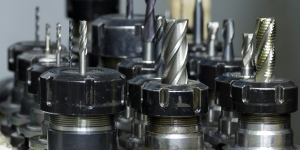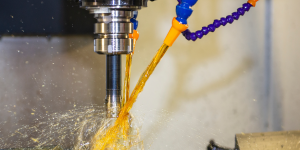CNC Milling utilise des commandes informatisées et des outils de filage multi-points pour supprimer le matériel de la pièce. La seule raison de la popularité de cette technique en voiture, aérospatial, et les industries électroniques sont l'efficacité et la précision.
CNC Milling est un outil important en production. CNC Milling a révolutionné le processus de création de composants en relevant les défis de la création de formes et de conceptions complexes avec précision. Une telle machine peut effectuer des tâches de fabrication qui seraient autrement impossibles ou nécessitent beaucoup de travail et de temps. L'automatisation de CNC Milling et sa capacité à répéter les opérations le rendent supérieur au broyage traditionnel. Les systèmes de production peuvent être configurés de sorte que les machines de fraisage CNC suivent les mêmes modèles et exécutent des coupes précises répétées pour des résultats cohérents. C'est parce que l'erreur humaine est omise et par conséquent, Il n'y a pas d'échecs de produit.
Comprendre le fraisage CNC
Le fraisage CNC est multiforme, et cela implique de nombreux processus pour la production d'un composant souhaité. Les programmes de CAO génèrent généralement la conception des pièces d'abord. Une conception est convertie en un programme CNC par le logiciel CAM. La broche tient l'outil de coupe, La table de travail sécurise la pièce, et les axes régulent le mouvement de l'outil de coupe dans un broyeur CNC. Ces axes peuvent se déplacer dans diverses directions dans un certain nombre de directions, Permettre une coupe et une mise en forme plus complexes.

La production de diverses fraisage CNC est effectuée pour différentes applications. Parmi ces, Nous avons vertical, horizontal, et les moulins de portique. La sélection de la machine dépend fortement de la taille de la pièce, forme, et précision. Fraisage CNC Les machines peuvent mouiller l'aluminium, acier, titane, plastiques, et matériaux composites. Force, poids, et la durabilité sont les principaux paramètres à considérer lors du choix du matériau dont le composant est fait.
Préparation de la machine à fraisage CNC
La sécurité de la machine doit passer en premier car elle est utilisée dans une fraiseuse CNC. Des équipements de sécurité tels que les gants et les lunettes doivent être portés et la machine doit être mise à la terre pour éliminer le risque de risques électriques. L'élimination de la poussière et les soins appropriés sont essentiels pour maintenir la course de fraisage CNC. Jeter les puces et les objets étrangers de l'espace de travail, huiler les pièces mobiles et examiner les dommages. L'entretien de routine peut même étendre le cycle de vie de l'équipement et éviter les échecs coûteux.
L'étalonnage et la précision du fraisage sont les caractéristiques qui doivent être suivies. Avant le fraisage, Assurez-vous que l'alignement de la machine et des erreurs sont vérifiés. Les dispositifs de mesure qui présentent une grande précision sont utilisés pour cette tâche, Par exemple, indicateurs de numérotation et dispositifs d'alignement laser. Préparez la surface en éliminant les ondulations. Une fois le broyage CNC, Les matériaux sont chargés. Les luminaires doivent serrer la pièce à la table de travail. Les visages pourraient également être utilisés. Les pièces doivent être correctement orientées avec l'outil de coupe pour empêcher les erreurs de frais.
Configuration du programme de fraisage CNC
La programmation CNC sera l'élément crucial de la configuration de la machine à mouler CNC. Il demande à la programmation de la machine pour se déplacer et couper le travail. Les opérations de la machine sont contrôlées par des langages de programmation tels que le code G et le code M qui font partie de CNC. La génération d'un programme de fraisage CNC est effectuée en utilisant un logiciel CAM. Le logiciel CAM donne à l'utilisateur la possibilité de construire des parcours d'outils en fonction de la conception de la pièce. Le système CAM détermine le meilleur programme pour l'outil de coupe, matériel, et les caractéristiques de traitement.
Avoir fini d'écrire le Programme CNC, Vous devez le charger sur la machine. Les mêmes informations peuvent être stockées et partagées à l'aide de disques flash ou de connexions USB ou Ethernet. Tout d'abord, Exécutez le programme pour vous assurer s'il y a des erreurs et vérifier également les incohérences avant le broyage.
Configuration et sélection de l'outil de fraisage CNC
Les outils de fraisage les plus appropriés sont la clé pour obtenir les meilleurs résultats. Par exemple, moulin à bout, frappeurs, et les moulins à boulets ont été développés pour des applications spécifiques. La sélection des outils de fraisage doit être basée sur le type de matériau, finition de surface, et paramètres d'usinage. La précision est l'une des étapes clés du processus d'installation de la machine à mouler CNC. Les porte-outils ou les collets doivent donc sécuriser l'outil dans la broche. L'instrument doit être positionné correctement en ce qui concerne la pièce et doit également avoir suffisamment de place pour se déplacer pendant le processus de fraisage.
L'efficacité du broyage ne peut être obtenue qu'en optimisant la génération de chemin d'outil. Cela peut être fait en calculant le meilleur parcours d'outils en fonction du taux de coupe, Les forces exercées sur les outils d'usinage et la durée de vie de l'outil. L'optimisation du chemin d'outil réduira le temps d'usinage et augmentera la productivité.
Méthodes de fraisage CNC composant parfait
Une myriade de techniques de fraisage peut fournir aux composants la précision nécessaire. Exemple: Le broyage des contour est un processus d'usinage où une pièce est coupée le long de son contour pour produire une forme ou un profil spécifique. Le broyage de poche est le processus de sortie du matériau d'une poche ou d'une cavité sur une pièce. Le forage est une opération, qui consiste à créer des trous dans la pièce.
Atteindre une bonne performance de fraisage nécessite d'adhérer à un ensemble de meilleures pratiques. Cela englobe le choix des paramètres de coupe optimaux, par exemple, vitesse de coupe, vitesse d'avance, et profondeur de coupe, Selon le matériau de la pièce particulière. À part ça, Une surveillance étroite et une altération des méthodes du processus peuvent être la clé du succès.

Le dépannage des problèmes de fraisage CNC est une autre chose importante que le fraisage CNC implique. Usure, La qualité de la surface laisse beaucoup à désirer, ou l'inexactitude dimensionnelle sont les problèmes qui peuvent être remarqués pendant le fraisage. En arrivant aux causes profondes des problèmes et en leur appliquant des actions correctives, Les fabricants pourront réduire les déchets et ce, à son tour, entraînera une meilleure qualité de produits.
Inspection post-module et contrôle de la qualité
Après le processus de fraisage, Il devrait y avoir une inspection qui contribuera à la production de composants broyés corrects et exacts. Une inspection visuelle est effectuée pour voir s'il y a des défauts physiques à la surface du matériau ou non. L'utilisation d'instruments de mesure tels que les étriers, micromètres, ou cmm, peut être appliqué pour vérifier la précision des dimensions.
Les mesures de contrôle de la qualité doivent être configurées afin que les résultats de fraisage ne varieraient pas avec chaque instance. Cela implique le réglage de la machine CNC qui implique l'étalonnage du système CNC, Par exemple, Pour améliorer la précision et la répétabilité de la machine. À part ça, Systèmes de gestion de la qualité, Comme ISO 9001, devraient être mis en œuvre par l'informatique pour normaliser tous les processus et la gestion qui seront faits. La prise et l'enregistrement des résultats de fraisage sont le principal problème de la traçabilité et de la transparence. Les enregistrements doivent être conservés en dépensant tous les processus de fraisage, Paramètres d'outillage, et les résultats d'inspection. Un Miller peut avoir une image claire de ce qui ne va pas et des tendances en enregistrant simplement tout le processus de fraisage. Les commentaires peuvent être utilisés pour guider le processus pour prendre les mesures correctives nécessaires.
En conclusion, CNC Milling est un processus exigeant que l'opérateur doit envisager de préparer la machine, Créer le programme, et exécuter correctement le travail pour obtenir les résultats souhaités. Les entreprises sont en mesure d'obtenir des composants précis et moins sujettes aux erreurs en adhérant au guide étape par étape précédemment décrit. L'incorporation de contrôle numérique informatique (CNC) Les moulures ont révolutionné les activités de fabrication en rendant possible un degré élevé de précision et d'efficacité opérationnelle qui étaient auparavant impossibles à obtenir des méthodes de fraisage conventionnelles. Ainsi que l'innovation de la technologie et la recherche de ce secteur, CNC Milling restera un élément irremplaçable dans la création d'une variété de composants industriels.
